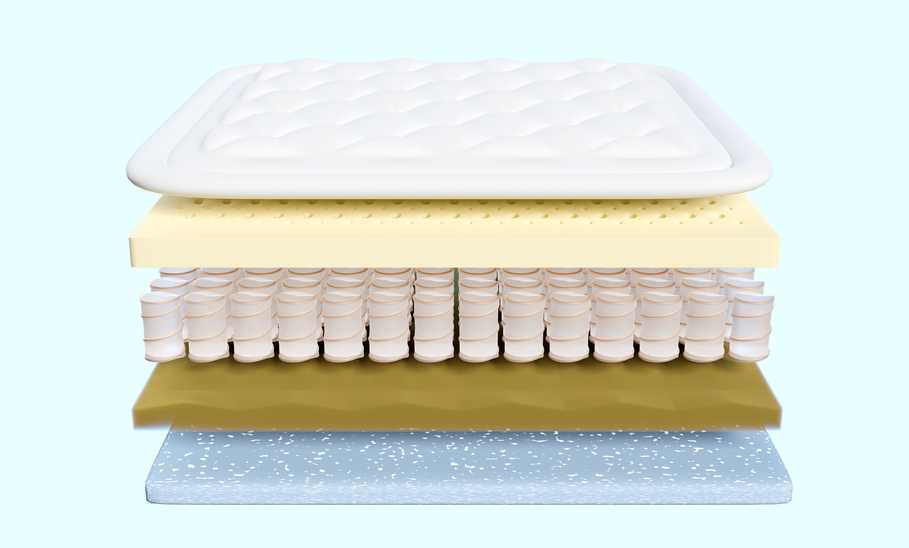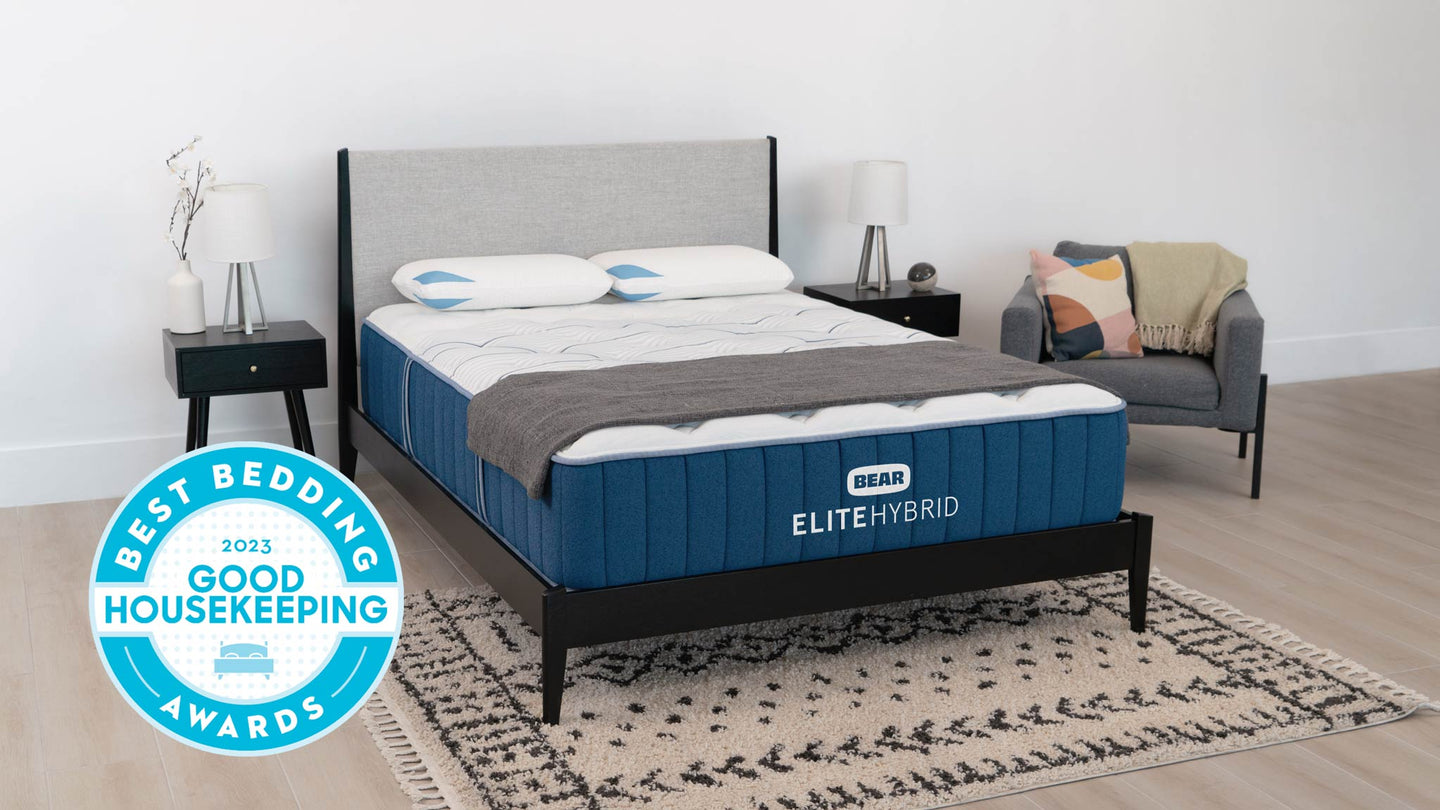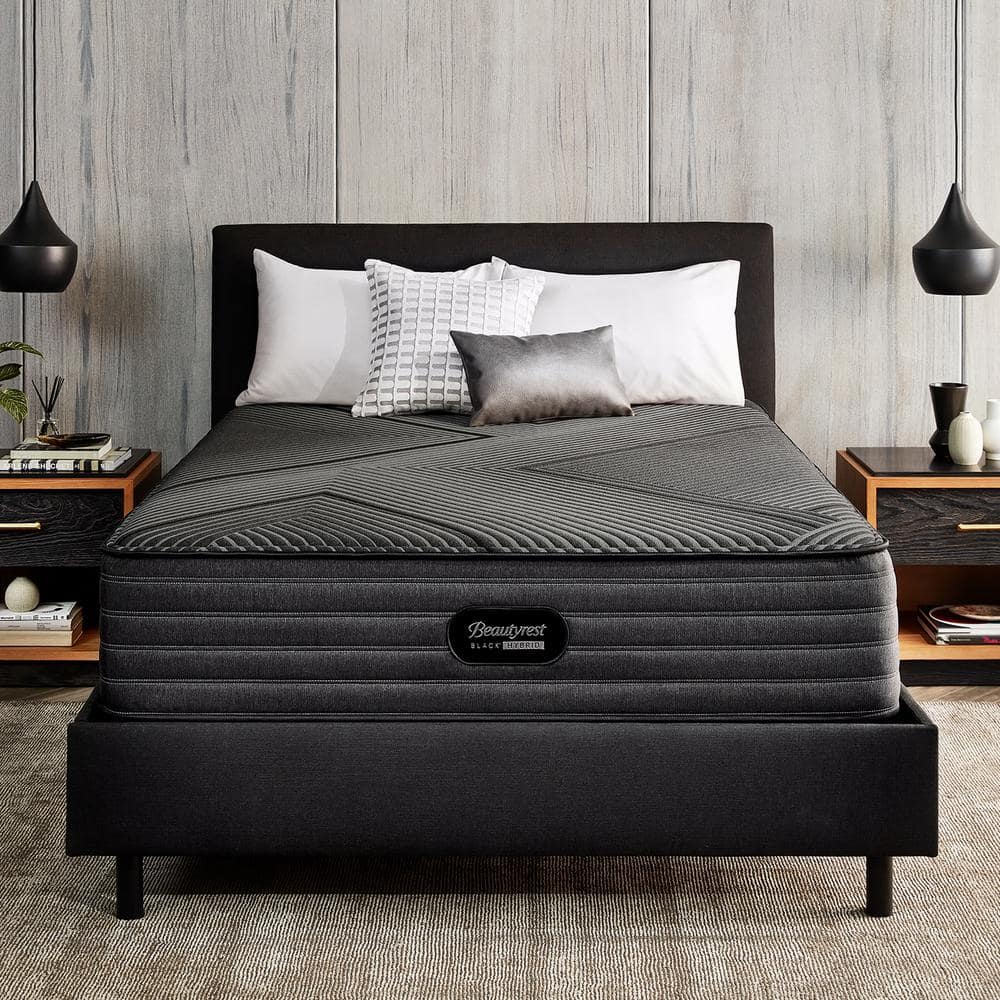What is a Hybrid Mattress—and What Makes Them So Popular?

Our evaluations and opinions are not influenced by our advertising relationships, but we may earn a commission from our partners’ links. This content is created by TIME Stamped, under TIME’s direction and produced in accordance with TIME’s editorial guidelines and overseen by TIME’s editorial staff. Learn more about it.
A solid night’s sleep (or a rejuvenating daytime nap) depends on quality bedding. When considering a new mattress, there are three common types: Innerspring, foam (gel, memory, or latex are common), and a third, a hybrid of the two. Read on to learn more about this popular mattress, why it’s a consumer-recommended choice for comfortable rest, and how to choose the best one.
A hybrid mattress is made of layers—a core coil support system and comfort material made of polyfoam, foam, latex, or gels. Basically, a hybrid combines the best of all mattresses into one product.
You can expect a soft mattress cover, memory foam layers, a cooling layer made of gel, and a core layer of individually pocketed coil springs responsive to a sleeper’s pressure that provide support.
All of these elements work together to provide all things critical to a good night’s sleep—like support for the spine and back from the pocketed coil spring technology, cooling properties that keep you from overheating, and body-contouring material (typically three inches thick) to help you relax into the bed.
According to the International Sleep Products Foundation, since 2020, 46% of consumers are more likely to sleep on a hybrid or memory foam mattress than one with just springs. There are a few key differences between them.
The first is price. Hybrids are (often) more expensive than memory foam because of the additional materials needed to create them.
Real memory foam mattresses only contain open-cell memory foam, cooling gel memory foam, or the original material—polyurethane. Sitting or lying on memory foam, you sink into the mattress, which contours to your body. A hybrid mattress offers more support; you get the comfort of the memory foam, but the support of individual pocketed springs, which makes the experience different from a mattress without them.
Hybrid mattresses are gaining popularity over innerspring (a traditional set of coils; think of your grandmother’s box spring bed, for example) and the popular choice of memory foam. Because hybrid mattresses contain both springs and cushions, they are adaptable to different sleeping styles and bodies.
Hybrid mattresses also provide edge support, so when you end up toward the end of the bed, you are still supported by the mattress.
Hybrid mattresses are becoming more popular with consumers because they adapt more than the traditional spring mattress and offer components of comfort, like pressure relief and breathability due to the layer of individual pocket springs and gel layer to help keep your body feeling cool.
Hybrid mattresses relieve pressure because the individual pocket coils adapt to your body’s shape and sleeping style—whether you’re a side or back sleeper.
Hybrid mattresses are a good choice for couples because they do well with motion isolation in the bed. This is because the coils are usually individually wrapped to isolate motion, and the layers of foam and gel resting over the core coil component help stop motion transfer while you’re sleeping.
The individual coils and layers help enhance the hybrid mattress’ breathability. These mattresses allow air to circulate because of the different types of layers within one mattress.
Because they are made up of many layers and components, hybrid mattresses are extremely durable, which is good because hybrids tend to cost more than conventional innerspring mattresses. The Better Sleep Council recommends replacing your mattress after seven years, but depending on how you use and care for it, it could last up to a decade. If properly cared for, a hybrid mattress can make it over the 10-year finish line.
A hybrid mattress has individual wrapped and pocketed coils that will move with your body and reduce motion transfer when sleeping.
The comfort layers in a hybrid mattress sit on top of the innerspring coils. These are often made of memory foam, micro-coils, latex, polyfoam, or a combination of the four. The type of comfort layers depends on the manufacturer of the hybrid mattress. Depending on the type of hybrid, an additional cooling layer might be included, usually made of gel, which will help slow down body heat to the mattress.
A transition layer is sandwiched between the supportive coils and the soft comfort layer. Usually, this layer is added to make sure there’s a padded buffer to give your body more support and stability. Most transition layers are made from similar materials as comfort layers, like foam.
Whether or not you own a hybrid, a cover can enhance the life of your mattress and add comfort. Usually made of cotton, poly-blend, or wool, a mattress cover is an important component of a hybrid (or any other) mattress. These covers also help keep dust, dirt, and fluids off the mattress. You can usually remove and clean a mattress cover, but like all bedding, read the directions on the tags before dumping it into a washing machine.
Read Article: Best Soft Mattresses: 8 Supportive Options, From Hybrid to Memory Foam
There are a few things to consider when shopping for a hybrid mattress, or any mattress, for that matter. Ask yourself the following questions:
As noted above, hybrids are often more expensive than innerspring or memory foam mattresses, so make sure you are prepared to pay more for your new hybrid.
Overall, hybrids are highly supportive, due to their extensive support network of individual pocketed coils, as compared to memory foam. The firmness of your mattress is a personal preference. It may be worth trying out a mattress before buying it, and many sellers allow you to do that for a trial period.
Do you sleep on your side or stomach? Hybrid mattresses support these types of sleep styles, along with those who sleep on their back. An important feature of a hybrid is its ability to support nearly all sleeping positions comfortably. If you overheat easily at night, look for a hybrid mattress with a cooling gel layer.
Evaluating different firmness levels is subjective, as what feels hard to one person may not be hard enough for another. You will need to try out different mattresses (some companies allow for a trial period), but most mattresses have a scale from one to nine in terms of extremely soft to ultra firm. Most hybrids have a medium firmness due to the mix of layers, containing both supportive and comfortable properties.
Most mattress companies sell one or more hybrid models. Some of the best mattresses out there include hybrids from the following companies, all of which offer various trial periods to test your hybrid.
The Helix Midnight Luxe is an ideal mattress for side sleepers who need that extra bit of comfort for their pressure zones and stability for their spine. It features four different layers of foam (a comfort layer, a cooling, antibacterial copper-infused layer, a transition layer, and a dense, durable base layer) sandwiching up to 1,000 individually wrapped coils.

Hot sleepers rejoice, because Brooklyn Bedding’s Aurora Luxe Cooling hybrid is jam-packed with cooling technology. Starting with a GlacioTex cooling cover, the mattress also boasts an antimicrobial foam layer with thermoregulating Phase Change Material, a cooling gel-infused memory foam layer, and around 1,000 encased coils that help to provide air flow along with support.

The Bear Elite Hybrid is a fantastic, high-end all-rounder, featuring copper-infused memory foam for cooling and cleanliness, great pressure relief for backs, hips, and shoulders, and a strong support system for durability and spinal alignment. Each mattress also comes with a free sleep accessories set, which includes two pillows, a sheet set, and a mattress protector.

An even more luxurious option is the Nolah Evolution, a seven-layer hybrid with, from top to bottom, two inches of quilted, breathable Euro Topper foam; a four-inch AirBreath heat escape gusset to help cool you down; two inches of pressure-relieving AirFoam; two inches of CoreComfort support foam; an inch of transition foam; eight inches of individually wrapped coils; and a final layer of stabilizing recycled plant fiber.
The perennially well-reviewed Leesa Sapira Hybrid is ideal for those who want softness and comfort, but not at the expense of motion transfer reduction. A medium to medium-firm mattress, it features layers of premium foam around a springy, supportive coil center. You also get free shipping, a ten-year warranty, and a 100-night trial period.

The Puffy Lux Hybrid is one of the best mattresses for back pain because its high-density foam in the comfort level was specifically designed for spine support and to reduce back discomfort in bed. A hypoallergenic cover is included with the mattress.

The Beautyrest Black Hybrid is another memory foam and innerspring hybrid. However, it uses a trademarked T3 Pocketed Coil Technology, which the company claims to provide 20% more support at sleepers’ highest pressure spots. In addition, this hybrid has a plant-based cooling system that may beat other hybrid mattresses. Called AirCool, the company claims it provides 18% more cooling power when you sleep.

The Purple RestorePremier Hybrid mattress created its signature technology called GelFlex Grid and Responsive Coil Core. Together, these features offer pressure relief and lets air circulate. The design of the grid’s columns offers contour to shoulders and hips, but your legs and back are supported, ideal when you’re trying to sleep with pain.

Yes. Hybrid mattresses are good for people struggling with back pain or discomfort because of their contouring ability and supportive core section of the mattress. While some people with back pain prefer a firmer surface, there are hybrids, like some of the ones mentioned above, designed specifically for people with back trouble.
Hybrid mattresses are good for side, back, and stomach sleepers. They are friendly on joints and backs, plus you can buy ones with a layer of cooling gel. These mattresses offer the best innerspring and memory foam options, and if you can afford the higher price tag, consider one—and for even more in-depth information, check out our guide on how to choose a mattress.
Like all bedding, including mattresses, you will need to take care of your mattress for it to last a long time. Most hybrids last from eight to 10 years.
If you get overheated easily, consider a hybrid mattress with a cooling component. Memory foam can trap heat, so if your hybrid is built with memory foam (and likely it is), and you’re concerned about it, find one with another or an additional comfort layer with gel or micro-coils, which can help move airflow and keep you cooler.
Yes. After extensive research on mattresses, including hybrids, we found these blended bed mattresses are good for all sleeping positions, thanks to the individually wrapped pocket coils and edge-of-the-bed support.
The cost of a hybrid mattress depends on its size and manufacturer and how many comfort and transitional layers it contains. For example, a queen-sized hybrid mattress may cost around $1500 to $2000 or more.
Related Read: The Best King Size Mattresses for a Luxurious Night’s Sleep
The information presented here is created by TIME Stamped and overseen by TIME editorial staff. To learn more, see our About Us page.



